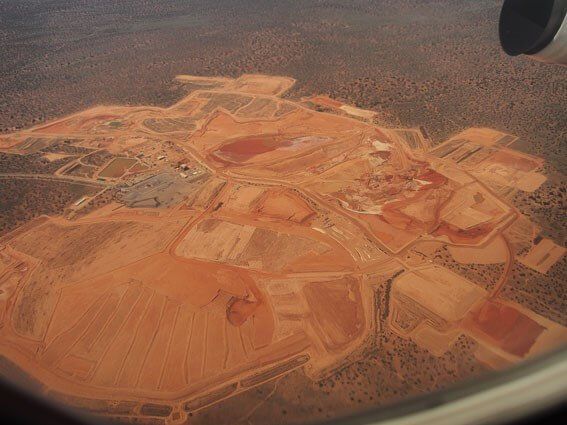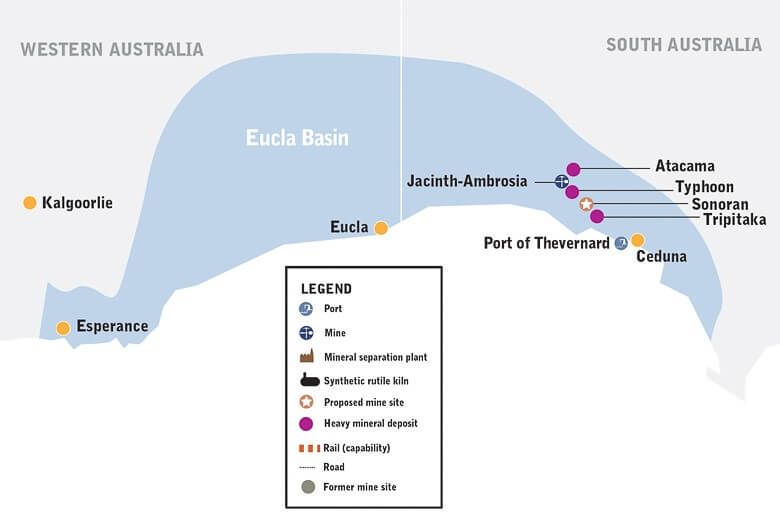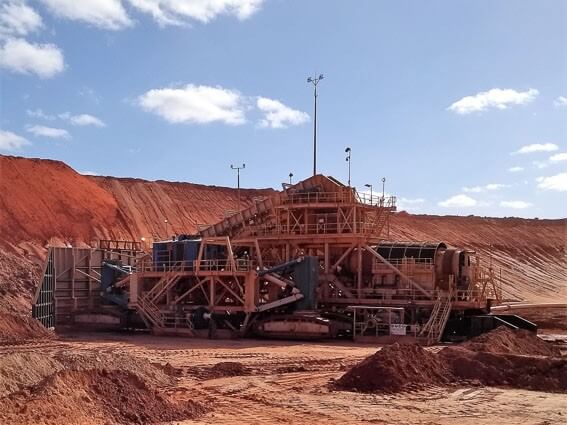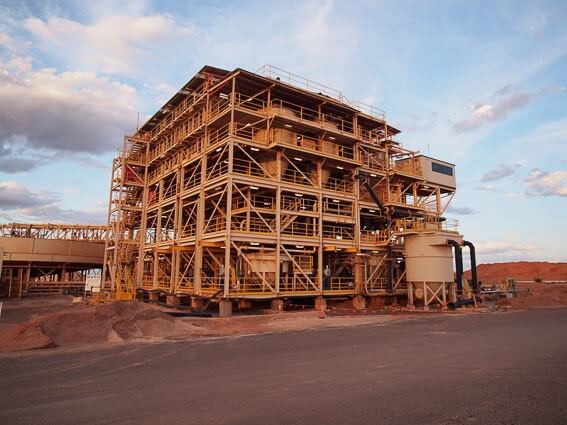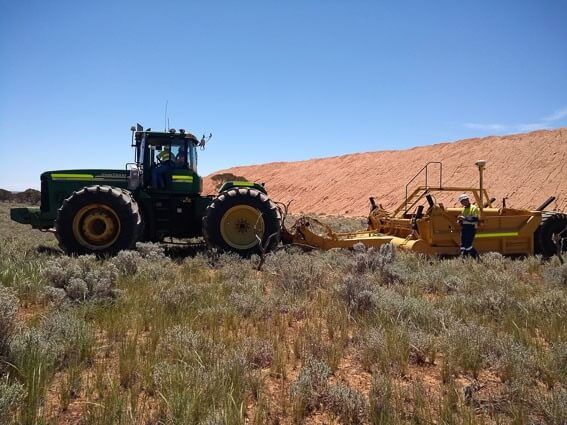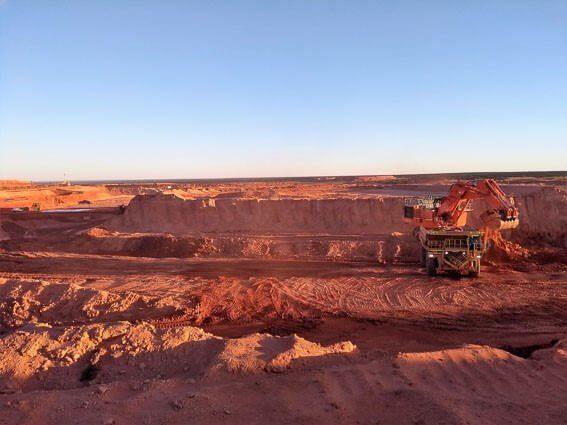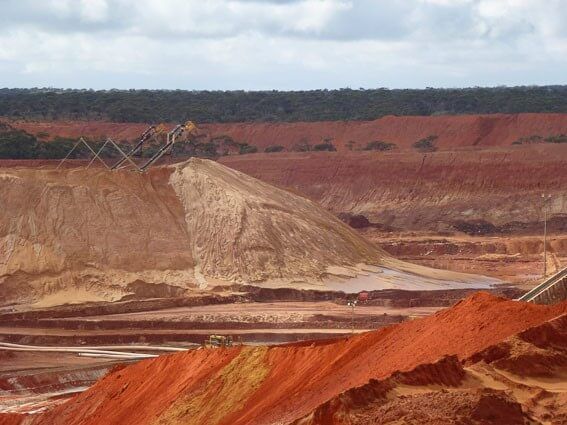Iluka’s Jacinth-Ambrosia: A dive into the largest zircon development globally
The Jacinth-Ambrosia Project
Iluka’s Jacinth-Ambrosia (JA) is considered the largest zircon development globally, with a current production capacity of approximately 300,000 tpa of Zircon. The JA mining and concentrating operation (Figure 1.1) is located in the Eucla Basin, 800 kilometres from Adelaide, South Australia, and 270 kilometres from the Port of Thevenard near the township of Ceduna (Figure 1.2).
The heavy mineral concentrate (HMC) produced in JA is basically composed of:
50% zircon (ZrSiO4) – used in the manufacture of ceramics (tiles and sanitary ware) and zirconium chemicals.
28% rutile (TiO2) – used in the production of white pigments, titanium metal, and welding electrodes.
5% ilmenite (FeTiO3) – used to produce synthetic rutile
My first secondment at Iluka’s Jacinth-Ambrosia (JA) mine site was in July 2014. That was the start of a great client relationship that has resulted in several other secondments in the following years. The latest secondment has also been the longest one, which started in June 2017 and finished on 4 July 2018.
JA Mining Method
The mineral sands in JA is mined in an open pit by dozer push, with concomitant rehabilitation as the mine advances. The individual mining blocks are shaped in a semicircle with a radius of 145m. A semi-mobile mining unit plant (MUP – Figure 2.1) with a feed capacity of 1,400 t/h, is positioned in front of the block that is going to be mined, at the mid-point of the block’s semi-circle diameter, and dozers push the mineral sands to feed it (Figure 2.2).
In the MUP, the oversize is separated from the sand through a series of screens and trommel, and is mixed with water, creating a pulp that is then pumped to the processing plant.
In the processing plant (Figure 2.3), which has a feed capacity of 1,000 t/h, the heavy minerals are concentrated mainly by gravity separation methods (spirals). When the block being mined is completed, the MUP moves to the next block, following a sequence defined in the mining plan. The MUP move involves a lot of survey work and earthworks for construction of the path where the MUP will tram, any required manoeuvre pads, and the final MUP pad in front of the block to be mined. Every week an MUP move meeting is held to plan and monitor progress of works for the next MUP move.
The removal of topsoil and subsoil (a layer of 300 mm combined) is carried out by tractor scoops (Figure 2.4) while the rest of overburden and interburden (layer of waste sand in the middle of the block) removal is done by traditional truck and excavator operation (CAT 785 and Hitachi EX2500 – Figure 2.5).
Interburden is not present in all blocks, but when it is, it may require the MUP to be moved to another block once the interburden is exposed. The MUP returns once the trucks and digger have removed the interburden and the lower layer of ore is exposed.
The tailings from the processing plant is divided into sands and ModCod (Modified Co-disposal – a mixture of slimes and fine sand).
As the mining progresses, the sand from the tailings is used to construct sand walls (30 to 35 m high) within old mined areas with the use of sand stackers (Figure 2.6). These walls create cells in the pit void that are used as ModCod deposition areas.
Once these cells are filled-up with ModCod to a predefined height, they are then covered with overburden, subsoil and topsoil, matching the profile of the original terrain, and rehabilitated.
Projects
JA was put in suspension for a period of 20 months before restarting operations in December 2017. During the suspension period, only rehabilitation works were carried out in the mine site. I was lucky enough to be present on the day the mine operations were suspended (16 April 2016), and when the operations re-started (14 December 2017).
During this last secondment, I was involved in the preparation works prior to restart of the mining operations, which included the design of an upgrade of the capacity of ModCod (tails) storage capacity. This entailed raising the existing cell wall embankment through engineered construction, reviewing the pit design, and designing new mining blocks for accurate schedule of the southern pit.
A couple of months prior to the restart of the operations a new earthworks contractor (Piacentini) was brought onboard, with new people and new equipment, and along with it came the challenge of managing the new contractor. Once mining operations restarted, apart from daily production monitoring activities, I participated in the design and construction of MUP pads and paths for MUP moves, overburden stockpile designs, monitoring of tailings embankment construction, monitoring of topsoil and subsoil stripping, as well as rehabilitation works, and surface water management, among other tasks.
JA has been a very interesting, enjoyable, and challenging project to work at, where I was able to apply a lot of my skills and learn a lot of new ones. Not to mention the good friends I made while working there.
Subscribe for the latest news & events
Contact Details
Useful Links
News & Insights

